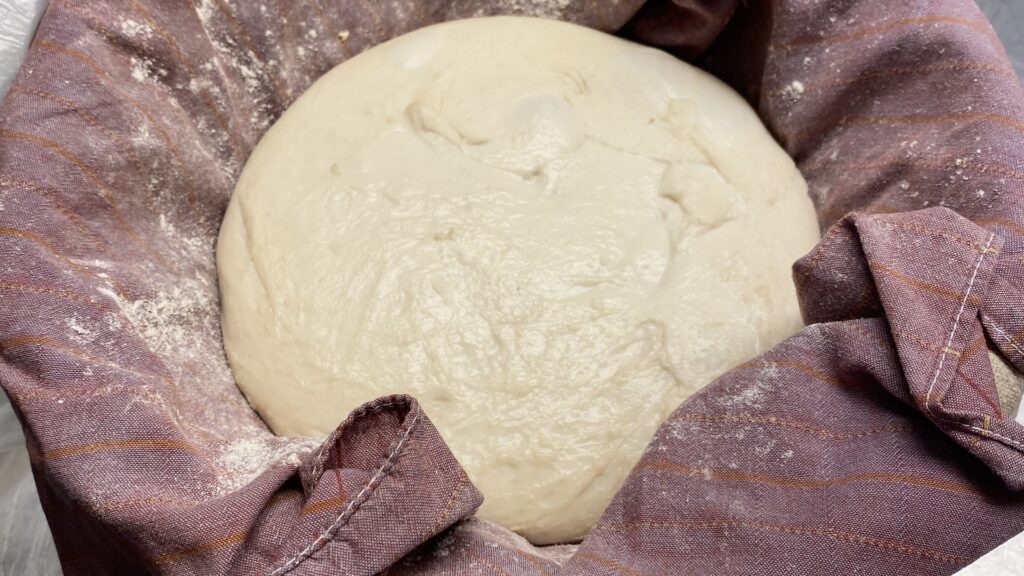A friend kindly gave me a copy of The Perfect Loaf, by Maurizio Leo, and very fortunately there was just about enough room in my suitcase to bring it home with me. The explanatory section at the start is very informative, even if most of it was pretty familiar already, and I did pick up a few new ideas. Still, the proof of the pudding and all that … so I resolved to make his Simple Sourdough.
My starter had been in the fridge for three weeks, so the night before starting I took it out and refreshed it so that it at least somewhat resembled Maurizio’s starter. Then I mixed up his leaven, 200 gm at 100% hydration. Normally, I don’t do much to adjust desired dough temperatures, preferring to adjust timings based on the leaven or dough’s behaviour. This time, I did try and adjust. It’s not easy, and I overshot by 2 degrees F. Also, because the house is pretty cold (19°C, 67°F), I stuck the leaven in the oven with the lamp on. Now to wait.

One thing already: if I pursue his methods, I may have to invest in some larger straight-sided Weck jars because they are so much easier to work with.
With the leaven approaching ripeness, I made up the autolyse as suggested. Dough temp ended up high (84°F), meaning that I made too much allowance for the very heavy glass bowl in which I make quantities of dough. And at 60% hydration, I didn’t really expect the dough to be “shaggy and loose” as forecast; it wasn’t. Wondering whether, when the time comes to mix in the leaven, it will be “firm yet sticky” before I start to strengthen. I doubt it. I’ll almost certainly need the full amount of the reserve 60 g of water.
Of course it was firm and sticky; silly me. Maurizio’s method is essentially a form of bassinage and even without the additional water, which I did add, incoporating the somewhat liquid leaven is a sticky procedure. I had completely forgotten how that worked, as I haven’t made ciabatta in a long time, so sticky it was, although now, after two stretch-and-folds it is much more manageable and the liquid much more evenly distributed.
At the end of the bulk fermentation the dough was certainly lively and jiggly, and also a lot more extensible than I am used to. Final dough weight was 1860 gm, which for 1100 gm flour (my leaven was 20g shy) gives a final hydration of 67%. All I can say to that is, it certainly didn’t feel like it. It felt more like 75%. I managed the shaping OK and got the loaves into my bannetons and into the fridge, but I’m honestly not convinced an absolute beginner would have managed.
When the time came to bake, this morning, the loaves spread somewhat alarmingly, but there was a clear skin and when I scored them I could see good bubbles. They baked up pretty well, nice blistering, though the spring, especially on the first one, was a little disappointing.
The second loaf, with a single long score, produced something I’ve not seen before. If you look closely, you can see a smooth area just inside the cut line, and then the usual thready area where the loaf actually split. I’m not sure why that happened. Maybe something to do with the way the dough spread after scoring and before I could get it into the casserole.
The crumb shot reveals what I suspected, that the dough was underproofed, probably in bulk. The eating, though, was very acceptable. Will I make it again? That’s the acid test, I suppose, and I think the answer is No. I don’t have any 100% white flour breads in my usual repertoire, although I have made Jeffrey Hamelman’s San Francisco Sourdough on occasion, and for me this one is not a keeper.
It isn’t fair to judge the entire book on the basis of this one effort, that’s for sure, and I will admit it was fun to try something completely new, like adjusting dough temperatures carefully. My hot-bread take, though, is that for an experienced baker, the simple sourdough recipe is perhaps going to be a let down. However, as I said, there is a lot of other information about sourdough baking that will, I am sure, prove valuable. For instance, I plan to use Maurizio’s quasi-lamination technique to incorporate inclusions next time I need to. Messing about with the amount of pre-fermented flour is also something to try. The other recipes are definitely a source of inspiration, although I may well use some of my own trusted techniques to produce them. As for the temperature-focussed process, I’ve concluded, on the basis of this single trial, that it isn’t for me. The house is too underheated in winter and poorly insulated in summer to make it worthwhile, and I certainly do not intend to invest in a heated proofing box, so I will just stick with my own advice and watch the dough, not the clock.



